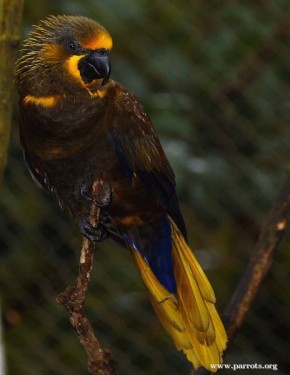
Brown Lory
[order] PSITTACIFORMES | [family] Psittacidae | [latin] Chalcopsitta duivenbodei | [authority] Dubois, 1884 | [UK] Brown Lory | [FR] Lori duyvenbode | [DE] Braunlori | [ES] Lori Pardo | [NL] Duyvenbode’s Lori | [copyright picture] Steve Milpacher
Subspecies
| Genus | Species | subspecies | Region | Range |
| Chalcopsitta | duivenbodei | AU | n New Guinea | |
| Chalcopsitta | duivenbodei | duivenbodei | nw coast of New Guinea | |
| Chalcopsitta | duivenbodei | syringanuchalis | ne coast of New Guinea |
Genus
Chalcopsitta is a genus of parrot in the family Psittacidae and the subfamily Loriinae. All four species are found on the islands of and around New Guinea and the Solomon Islands. The four species of the Chalcopsitta genus are about 31 – 32 cm (12 inches) long. They have long tails, and prominent bare skin at the base of the lower mandible.
Physical charateristics
Dark brown feathers; yellow forecrown, chin, thighs, under-wing converts, innerwebs of primary feathers and bend of wing; also purple rump and black bill. Eye orange/red. C.d. duivenbodei: body dark olive/brown, forehead and face yellow; feathers of breast margined yellow, bend of wing, thighs and underwing covers orange/yellow; yellow markings on outer tail feathers in male. C.d. syringanuchalis: darker brown head and back; often with purple sheen.
Listen to the sound of Brown Lory
[audio:http://www.planetofbirds.com/MASTER/PSITTACIFORMES/Psittacidae/sounds/Brown Lory.mp3]
Copyright remark: Most sounds derived from xeno-canto
recorded by Patrik Aberg
| wingspan min.: | 0 | cm | wingspan max.: | 0 | cm |
| size min.: | 31 | cm | size max.: | 33 | cm |
| incubation min.: | 22 | days | incubation max.: | 26 | days |
| fledging min.: | 75 | days | fledging max.: | 85 | days |
| broods: | 1 | eggs min.: | 1 | ||
| eggs max.: | 3 |
Range
Australasia : North New Guinea. This species has a patchy distribution along the northern coastal lowlands of New Guinea, from the Geelvink Bay in Irian Jaya (Indonesia) to the Astrolobe Bay in Papua New Guinea.
Habitat
It favours a type of primary and tall secondary forest which has only been recorded below 150 m
Reproduction
Only data from capitvity, clutch size 2 eggs incubated for about 2-4 weeks. Young fledge after about 11 weeks.
Feeding habits
Nectar from flowering trees, and fruit.
Video Brown Lory
httpv://www.youtube.com/watch?v=ebwC5owo7dA
copyright: Josep del Hoyo
Conservation
Although this species may have a restricted range, it is not believed to approach the thresholds for Vulnerable under the range size criterion (Extent of Occurrence <20,000 km2 combined with a declining or fluctuating range size, habitat extent/quality, or population size and a small number of locations or severe fragmentation). The population trend appears to be stable, and hence the species does not approach the thresholds for Vulnerable under the population trend criterion (>30% decline over ten years or three generations). The population size has not been quantified, but it is not believed to approach the thresholds for Vulnerable under the population size criterion (<10,000 mature individuals with a continuing decline estimated to be >10% in ten years or three generations, or with a specified population structure). For these reasons the species is evaluated as Least Concern.
Forests throughout its range are threatened by commercial logging but the species’s abundance in secondary forest suggests that it is not threatened.
Forests throughout its range are threatened by commercial logging but the species’s abundance in secondary forest suggests that it is not threatened.

Migration
Probably resident
Distribution map

